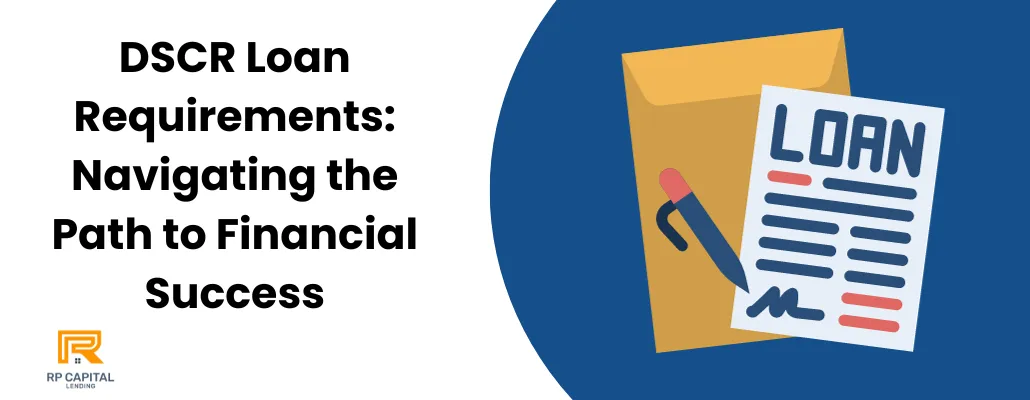Blog

DSCR Loan Requirements: Navigating the Path to Financial Success
Investing in real estate requires strategic financing options, and one such tool is the DSCR loan. Standing for Debt-Service Coverage Ratio, DSCR loans offer a unique pathway for real estate investors to secure funding based on property income rather than personal finances. If you're curious about how these loans work and what requirements you need to meet, this blog is your one-stop guide.
What is a DSCR Loan?

A DSCR loan is a type of commercial loan primarily designed for real estate investors. Unlike traditional loans, DSCR loans focus on the income generated by the investment property to determine eligibility. This makes them ideal for borrowers with fluctuating or unconventional incomes, such as self-employed individuals or seasoned investors.
Why is DSCR Important for Lenders?
Lenders use the Debt-Service Coverage Ratio to assess a property's ability to cover its debt obligations. The formula for calculating DSCR is:
DSCR= Net Operating Income (NOI) / Annual Debt Payments
For example:
If a property generates a Net Operating Income of $120,000 annually and has annual debt payments of $100,000, the DSCR is:
120,000 / 100,00=1.2
This means the property earns 20% more than its debt obligations, making it a safer investment for lenders.
Key DSCR Loan Requirements: In-Depth Overview

To qualify for a Debt-Service Coverage Ratio (DSCR) loan, borrowers must meet specific criteria that demonstrate the viability of the property to generate sufficient income for covering loan payments. Below, we delve into each requirement in detail to give you a comprehensive understanding.
1. Minimum DSCR Threshold
The Debt-Service Coverage Ratio is the cornerstone of this loan. Lenders calculate it using the formula:
DSCR= Net Operating Income (NOI) / Annual Debt Payments
Threshold Requirements:
Most lenders require a DSCR of 1.0 to 1.5, depending on their risk tolerance.
A DSCR of 1.0 indicates that the property generates just enough income to cover debt payments.
Ratios below 1.0 signal risk because the income is insufficient to meet debt obligations, making lenders hesitant.
Pro Tip: Properties with a DSCR above 1.25 are more likely to secure approval, as they demonstrate a cushion for unexpected expenses or vacancies.
2. Property Income Documentation
Accurate and transparent documentation is critical to demonstrating that the property is a viable investment.
Required Documents:
Rent Rolls: A detailed record of current tenants, lease agreements, and rental income.
Financial Statements: Historical and projected income statements, including gross rental income, operating expenses, and net operating income.
Occupancy Rates: Consistent occupancy over time strengthens the application, as high vacancies may raise red flags.
Potential Challenges:
Properties with fluctuating rental income or high tenant turnover may face additional scrutiny.
New or recently renovated properties may need projected income statements validated by market studies.
3. Down Payment
DSCR loans require a significant upfront investment, making the down payment a vital consideration.
Standard Down Payment:
Lenders typically require 20% to 30% of the property’s purchase price as a down payment.
For higher-risk properties, such as those with low DSCR or less stable income streams, lenders may ask for a larger down payment.
Why It Matters:
A substantial down payment reduces the lender’s risk by ensuring you have equity in the property.
It also lowers the loan-to-value (LTV) ratio, which can improve loan terms such as interest rates.
4. Credit Score
While the primary focus of a DSCR loan is the property’s income, your credit score still plays a role in the approval process.
Minimum Credit Score:
Lenders generally require a credit score of 620–680, with higher scores preferred for favorable loan terms.
Impact of Credit Score:
A good credit score may result in lower interest rates and reduced fees.
Borrowers with poor credit might still qualify but could face higher rates or additional requirements like a larger down payment or reserves.
5. Property Type
DSCR loans are specifically tailored for investment properties, not owner-occupied residences.
Eligible Properties:
Residential rental properties (single-family homes, duplexes, multi-family units).
Commercial properties such as office spaces, retail spaces, and warehouses.
Mixed-use properties with rental income potential.
Ineligible Properties:
Owner-occupied properties are generally excluded because lenders focus on properties that generate cash flow rather than personal use.
6. Reserve Requirements
Reserves provide a safety net for lenders, ensuring you can continue making payments even if the property faces temporary challenges.
Typical Reserve Requirements:
Lenders often ask for 3–6 months of loan payments in liquid reserves.
This can include savings, stocks, or other easily accessible funds.
Why Reserves Are Essential:
They demonstrate financial stability and reduce the risk of default during unexpected situations like tenant vacancies or economic downturns.
7. Prepayment Penalties
Some DSCR loans include prepayment penalties, which are fees charged if you pay off your loan early.
Common Terms:
Penalties can range from 1% to 5% of the remaining loan balance.
These penalties often apply during the first 3–5 years of the loan term.
What to Look Out For:
Ask your lender if prepayment penalties apply and under what conditions.
If you plan to refinance or sell the property early, choose a loan with minimal or no prepayment penalties.
Advantages of DSCR Loans
DSCR loans come with distinct benefits that make them attractive to real estate investors:
1. No Personal Income Requirement:
Unlike traditional loans, DSCR loans focus on the property’s income rather than your tax returns or personal earnings.
2. Flexible Financing Options:
Ideal for borrowers with non-traditional income sources, such as self-employed individuals or those with multiple investment properties.
3. Faster Approval Process:
Minimal emphasis on personal financial history accelerates underwriting, allowing you to close deals quickly.
4. Scalability:
These loans make it easier to grow your real estate portfolio by leveraging the income of existing properties.
Common Mistakes to Avoid When Applying for a DSCR
Applying for a Debt-Service Coverage Ratio (DSCR) loan can be an excellent financing strategy for real estate investors, but even small mistakes can result in delays, unfavorable terms, or outright rejection. To increase your chances of approval and secure the best possible loan terms, avoid these common pitfalls:
1. Ignoring DSCR Calculations
The DSCR is the core metric lenders use to evaluate whether your property can generate enough income to cover its debt obligations. Overlooking its importance or miscalculating it can jeopardize your loan application.
Mistake:
Applying for a loan without verifying if your property meets the lender's required DSCR threshold, typically between 1.0 and 1.5.
Consequence:
If your DSCR is below the minimum threshold, lenders may view your property as too risky, leading to denial or less favorable terms.
How to Avoid:
Calculate your DSCR before applying. Use the formula:
DSCR= Net Operating Income (NOI) / Annual Debt Payments
Work with your accountant or financial advisor to ensure accuracy.
2. Insufficient Reserves
Many lenders require borrowers to maintain 3–6 months’ worth of loan payments in reserves as a safety net. Falling short in this area can derail your application.
Mistake:
Neglecting to set aside sufficient liquid reserves, assuming it won’t impact your approval.
Consequence:
Lenders may reject your application due to perceived financial instability.
How to Avoid:
Build a financial buffer by setting aside adequate reserves before applying. Include savings, investments, or other liquid assets to meet this requirement.
Provide documentation proving you have these reserves readily available.
3. Overlooking Hidden Costs
Hidden fees and penalties can significantly impact the cost of your loan over time. Failing to account for these can lead to unpleasant surprises later.
Mistake:
Not reading the fine print for potential prepayment penalties, origination fees, or other charges.
Consequence:
You may face unexpected costs if you refinance, sell the property, or pay off the loan early. High fees could also reduce your overall returns.
How to Avoid:
Review the loan agreement thoroughly, focusing on clauses related to fees and penalties.
Ask your lender about:
Prepayment Penalties: Fees for paying off the loan early.
Origination Fees: Upfront charges for processing the loan.
Rate Lock Fees: Costs for locking in an interest rate.
4. Skipping Professional Advice
Navigating the intricacies of DSCR loans without expert guidance can lead to costly mistakes or missed opportunities for better terms.
Mistake:
Relying solely on personal research or assumptions instead of consulting professionals.
Consequence:
You may end up with an unfavorable loan structure or miss critical details that affect your investment’s profitability.
How to Avoid:
Consult a financial advisor or mortgage broker who specializes in DSCR loans.
These experts can help you:
Compare lenders and loan products.
Optimize your application to meet lender requirements.
Understand long-term implications of loan terms.
5. Underestimating Property Performance
Some borrowers overlook the importance of presenting a strong case for their property’s income-generating potential.
Mistake:
Submitting incomplete or outdated rent rolls and financial statements.
Consequence:
Lenders may question the property’s ability to generate consistent income, delaying approval or increasing loan costs.
How to Avoid:
Provide detailed and accurate documentation of the property’s income, including:
Recent rent rolls showing lease agreements and occupancy rates.
Historical financial statements demonstrating stable cash flow.
Market analysis supporting the property’s rental potential.
6. Choosing the Wrong Lender
Not all lenders are the same, and some may not offer loan terms that align with your investment goals.
Mistake:
Applying with lenders who have rigid requirements or limited experience with DSCR loans.
Consequence:
You might receive higher interest rates, stricter terms, or even rejection if the lender is not a good fit for your property.
How to Avoid:
Research multiple lenders and compare their offerings.
Focus on lenders with expertise in DSCR loans and a track record of working with real estate investors.
How to Improve Your DSCR?
The Debt-Service Coverage Ratio (DSCR) is a crucial metric for lenders to evaluate your property’s financial health. If your property falls short of the required DSCR threshold, it doesn’t mean you’re out of options. You can take proactive steps to improve your DSCR, making your investment property more appealing to lenders. Let’s dive deeper into the strategies to enhance your DSCR.
1. Increase Rent: Boosting Net Operating Income (NOI)
Raising rental income is one of the most effective ways to improve your DSCR, as the formula for DSCR directly depends on the Net Operating Income (NOI). Here’s how you can approach this:
Review Current Rent Levels:
Compare your rental rates with market standards in the area. If your rates are below average, consider increasing them to align with market demand.
Use tools like property management software or online platforms to analyze local rental trends.
Implement Value-Added Improvements:
Upgrade amenities such as modern appliances, security systems, or high-speed internet access to justify higher rent.
Add community features like a fitness center, playground, or upgraded landscaping to increase the property’s value and appeal.
Offer Short-Term Rentals:
If allowed, switch from long-term leases to short-term rental options through platforms like Airbnb or Vrbo, which often yield higher monthly income.
Lease Vacant Units:
Minimize vacancies by adopting targeted marketing strategies to attract tenants. Offering move-in incentives or flexible lease terms can fill empty units faster.
Periodic Rent Reviews:
Establish a regular process to review and adjust rents annually or biannually, keeping pace with inflation and market trends.
2. Refinance Existing Loans: Reducing Debt Payments
Refinancing existing loans can lower your annual debt obligations, which directly improves your DSCR. Here’s how:
Secure a Lower Interest Rate:
Work with lenders to refinance your loan at a lower interest rate, reducing monthly payments.
Compare offers from multiple lenders to find competitive rates tailored to your property’s profile.
Extend Loan Terms:
Opt for a longer loan term to spread out payments over a greater period, thereby lowering the monthly debt service.
Example: Extending a 15-year loan to 25 years can significantly reduce monthly payments, freeing up cash flow.
Consolidate High-Interest Loans:
If you have multiple loans with varying interest rates, consolidate them into a single loan with a lower overall rate.
Negotiate New Terms:
Approach your lender to renegotiate payment terms, especially if the property has a solid income history or you’ve improved its performance.
3. Cut Operating Costs: Optimizing Property Management
Lowering operating expenses is another way to boost NOI, which, in turn, improves your DSCR. Here are steps to streamline your property’s operational efficiency:
Conduct a Cost Audit:
Analyze your property’s expense sheet to identify areas of unnecessary spending or potential savings.
Switch to Energy-Efficient Solutions:
Replace outdated lighting, HVAC systems, and appliances with energy-efficient models to lower utility costs.
Install solar panels or smart energy systems to further reduce expenses.
Renegotiate Service Contracts:
Work with vendors, contractors, and suppliers to negotiate better rates for property maintenance, landscaping, and other recurring services.
Automate Property Management:
Use property management software to streamline tenant communication, rent collection, and maintenance scheduling, reducing administrative overhead.
Preventive Maintenance:
Proactively address minor repair issues before they escalate into costly problems. Regular inspections and upkeep can reduce long-term expenses.
Control Staffing Costs:
If your property employs on-site staff, evaluate whether their roles can be optimized or if certain tasks can be outsourced more cost-effectively.
4. Diversify Income Streams
Sometimes, increasing DSCR requires thinking beyond standard rental income. Consider these additional revenue sources:
Add Paid Services:
Introduce paid offerings like laundry facilities, parking fees, or pet amenities to generate extra income.
Rent Common Spaces:
Lease out unused common areas for events, co-working spaces, or pop-up businesses.
Install Vending Machines:
Add vending machines or ATMs to generate small but consistent revenue streams.
5. Reassess Property Tax and Insurance Costs
Both property taxes and insurance premiums are significant operational expenses. Reducing these costs can help improve your DSCR:
Challenge Property Tax Assessments:
If you believe your property is overvalued, file an appeal with your local tax authority to lower your tax bill.
Shop for Better Insurance Rates:
Compare insurance providers and policies to ensure you’re not overpaying for coverage. Switching to a lower premium or bundling insurance policies can lead to savings.
6. Increase Occupancy Rates
Vacancies hurt your DSCR by reducing rental income. Focus on maintaining high occupancy rates through:
Targeted Marketing:
Use online advertising, social media, and local outreach to reach potential tenants quickly.
Highlight unique selling points of your property, such as location, amenities, and competitive rent.
Tenant Retention Programs:
Offer discounts for lease renewals or long-term leases to retain reliable tenants.
Regularly engage with tenants to ensure satisfaction and address concerns promptly.
Improve Property Appeal:
Maintain a clean, well-lit, and secure property to attract quality tenants.
Conclusion
DSCR loans are a powerful tool for real estate investors looking to expand their portfolios. By focusing on property income rather than personal financials, they offer a flexible and accessible financing option. However, meeting the requirements—such as maintaining a strong DSCR, having sufficient reserves, and documenting income—is essential for success.
Ready to take the next step? Start preparing for your DSCR loan today and unlock new opportunities in real estate investment!
FAQs
1. What is a good DSCR for a loan?
A DSCR of 1.25 or higher is generally considered strong by lenders.
2. Can I get a DSCR loan with bad credit?
While DSCR loans prioritize property income, most lenders require a minimum credit score of 620–680.
3. What documents are needed for a DSCR loan?
You’ll need rent rolls, financial statements, and proof of reserves.
4. Are DSCR loans only for rental properties?
Yes, they are primarily designed for investment properties like rentals and commercial spaces.
5. Do DSCR loans have prepayment penalties?
Some lenders include prepayment penalties, so it’s important to review the terms carefully.
Also Read:
Current DSCR Loan Interest Rates: Your Guide to Competitive Rates
The Ultimate Guide to Private Lending Interest Rates in 2024
What Is Table Funding? Definition, Benefits, and How It Works
Pros and Cons of Taking Loans from Private Lenders
RP Capital Lending is a d.b.a of RP Capital Partners Inc (NMLS # 2469193) | Privacy Policy
Copyright © 2022. All Rights Reserved.
Disclaimer: Loans only apply to non-owner occupied properties. Rates, terms and conditions offered only to qualified borrowers, may vary upon loan product, deal structure, other applicable considerations, and are subject to change at any time without notice.

